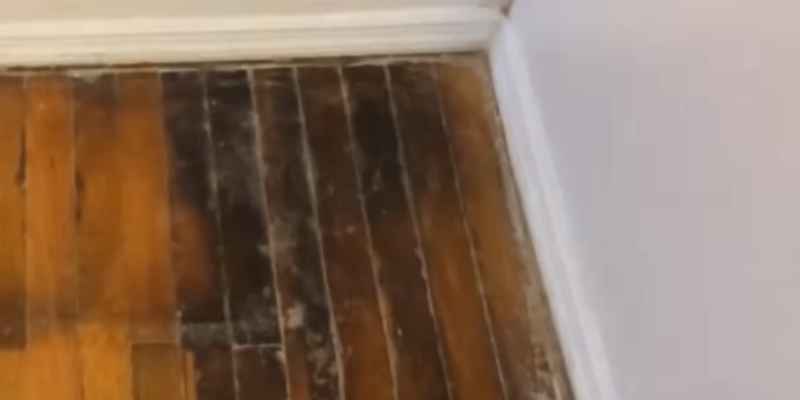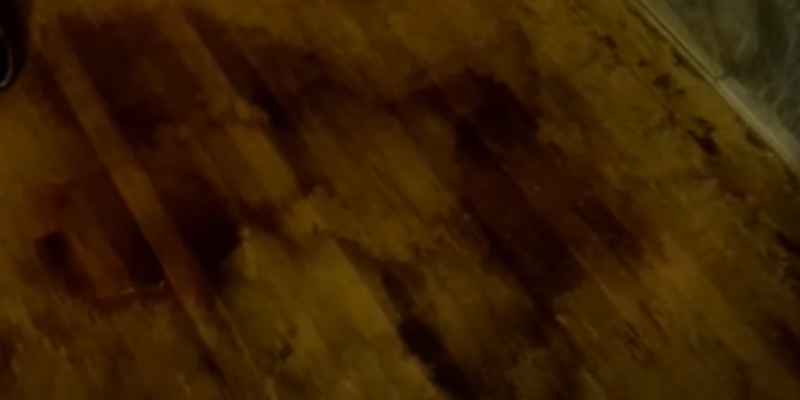To remove black urine stains from hardwood floors, begin by ensuring the stain is completely dry, then gently sand the area using fine-grit sandpaper. Apply a hardwood floor cleaner or a mixture of vinegar and water to the stained area, scrubbing with a soft cloth.
Repeat until the stain is gone, then rinse the area with clean water and dry thoroughly.
Understanding Black Urine Stains
Black urine stains on hardwood floors can be effectively removed by following these simple steps. Using a mixture of vinegar and water, gently scrub the stained area with a soft cloth. Rinse with clean water and dry thoroughly.
Black urine stains on hardwood floors can be a distressing sight. They not only affect the aesthetic appeal of your flooring but can also indicate underlying issues that may need attention. In this section, we will delve into the causes of black urine stains and explore their impact on hardwood floors.
Causes Of Black Urine Stains
Black urine stains on hardwood floors can have several causes, ranging from harmless to potentially serious. Understanding these causes can help you take appropriate measures to prevent and treat the stains effectively. Here are some common factors that contribute to black urine stains:
- Pet Urine: If you have pets, particularly dogs and cats, their urine can discolor hardwood floors over time. This discoloration occurs due to the presence of naturally occurring pigments and chemicals in the urine, which react with the wood’s surface.
- Water Damage: Excessive moisture or water exposure can seep into the wood and lead to stains. Mold and mildew growth resulting from water damage can also cause black stains.
- Chemical Reactions: Certain cleaning products or chemicals used on hardwood floors may react with the wood’s surface, causing discoloration. For instance, using ammonia-based cleaners can result in black stains.
- Aging: As hardwood floors age, they may naturally develop dark spots or discolorations. This is a normal process caused by years of exposure to sunlight, foot traffic, and wear and tear.
Impact Of Black Urine Stains On Hardwood Floors
Black urine stains can have a significant impact on the appearance and integrity of your hardwood floors. Here are some ways these stains can affect your flooring:
- Discoloration: The most obvious impact of black urine stains is the discoloration they cause on your hardwood floors. This discoloration can range from light brown to deep black, depending on the severity and duration of the stain.
- Stain Penetration: Black urine stains can penetrate deep into the wood fibers, making them harder to remove. If left untreated, these stains can become more ingrained over time, making the removal process even more challenging.
- Structural Damage: Prolonged exposure to black urine stains can weaken the wood’s structural integrity. The urine’s acidic nature can break down the wood fibers, leading to warping, cupping, or irreversible damage to your hardwood floors.
- Unpleasant Odor: Along with the visual impact, black urine stains can also emit a strong and unpleasant odor. This odor may persist even after you’ve cleaned the stain, especially if the urine has seeped into the wood.
In summary, black urine stains on hardwood floors can stem from various causes, such as pet urine, water damage, chemical reactions, and natural aging. Understanding these causes is crucial for effective stain removal and prevention. Moreover, it’s important to consider the impact of these stains on your hardwood floors, including discoloration, stain penetration, structural damage, and unpleasant odors. By addressing these issues promptly and with the right techniques, you can restore the beauty and health of your hardwood flooring.

Preventing And Treating Black Urine Stains
Want to remove black urine stains from hardwood floors? Discover effective techniques for preventing and treating these stubborn stains to maintain the beauty of your flooring.
Black urine stains on hardwood floors can be a frustrating and unsightly problem to deal with. Fortunately, there are proactive measures you can take to prevent these stains from occurring, as well as initial treatment steps to minimize the damage if they do happen. In this section, we will explore preventive measures, initial treatment steps, and intensive stain removal techniques to help you maintain the beauty and longevity of your hardwood floors.
Preventive Measures
To avoid black urine stains on your hardwood floors, it is essential to establish good habits and preventative measures. By following these simple steps, you can significantly reduce the chances of stains occurring in the first place:
- Ensure your pets have regular access to clean water, encouraging them to stay hydrated and minimize urine concentration.
- Establish a routine for pet walks or outdoor bathroom breaks to prevent accidents indoors.
- Consider using training pads or litter boxes to provide a designated spot for your pets to relieve themselves.
- Implement frequent cleaning and maintenance of your hardwood floors to remove any potential urine residue.
Initial Treatment Steps
If you notice black urine stains on your hardwood floors, it is crucial to take immediate action. Follow these initial treatment steps to prevent the stains from spreading or causing further damage:
- Blot the urine stain with a clean cloth or paper towel to remove as much liquid as possible.
- Mix a solution of equal parts water and white vinegar to create a homemade cleaner.
- Dampen another cloth or sponge with the vinegar solution and gently blot the stained area, being careful not to saturate the wood.
- Rinse the cloth or sponge with clean water and blot the area again to remove any residual vinegar solution.
- Dry the floor thoroughly with a clean towel or allow it to air dry.
- If the stain persists, consider using specialized hardwood floor cleaners or seeking professional assistance.
Intensive Stain Removal Techniques
In some cases, black urine stains on hardwood floors may require more intensive removal techniques. It is essential to proceed with caution to avoid any damage to the wood’s surface:
- Lightly sand the stained area using fine-grit sandpaper, following the grain of the wood.
- Apply wood bleach or oxalic acid to the affected area, following the instructions on the product carefully.
- Allow the bleach or acid to sit for the recommended time, then rinse thoroughly with clean water.
- Dry the floor completely and assess the stain. Repeat the process if necessary, but be mindful of over-sanding and causing further damage.
- Finish the treatment by applying a sealant or wood wax to protect and restore the affected area.
By implementing these preventive measures, taking immediate action with initial treatment steps, and utilizing intensive stain removal techniques when necessary, you can effectively prevent and treat black urine stains on your hardwood floors. Remember to always test any cleaning products or techniques in an inconspicuous area before applying them to the entire stained region. With patience and care, you can restore the beauty of your hardwood floors and maintain their pristine condition for years to come.
Natural Remedies For Eliminating Black Urine Stains
Black urine stains on hardwood floors can be a nightmare to deal with. Not only do they look unsightly, but they can also cause permanent damage if left untreated. Instead of resorting to harsh chemicals that can further harm your floors, consider trying these natural remedies that are not only effective but also safe for your hardwood surfaces.
Vinegar And Water Solution
One of the simplest and most effective ways to remove black urine stains from hardwood floors is by using a vinegar and water solution. Vinegar, with its acidic properties, can help break down the stain while also disinfecting the area.
- Mix equal parts of white vinegar and warm water in a bucket.
- Dip a clean cloth or sponge into the solution and wring out any excess liquid.
- Gently scrub the stained area in a circular motion, applying light pressure.
- Allow the solution to sit on the stain for a few minutes.
- Wipe away the solution with a clean cloth or mop, ensuring all residue is removed.
- Dry the floor thoroughly with a towel.
Baking Soda Paste
Baking soda is another effective natural remedy for removing black urine stains from hardwood floors. Its abrasive nature helps lift stains while also neutralizing any unpleasant odors.
- In a small bowl, mix enough baking soda with water to form a thick paste.
- Apply the paste directly onto the stained area, ensuring it is evenly distributed.
- Allow the paste to sit on the stain for at least 30 minutes.
- Gently scrub the stained area with a soft brush or cloth, using circular motions.
- Wipe away the paste with a damp cloth or sponge, ensuring all residue is removed.
- Dry the floor thoroughly with a towel.
Hydrogen Peroxide And Dish Soap Mixture
If the black urine stain is particularly stubborn, a mixture of hydrogen peroxide and dish soap can work wonders. Hydrogen peroxide acts as a natural bleaching agent, while dish soap helps break down the stain.
- In a spray bottle, mix equal parts hydrogen peroxide and dish soap.
- Spray the mixture directly onto the stained area, ensuring it is well soaked.
- Allow the mixture to sit on the stain for about 15 minutes.
- Gently scrub the stained area with a soft brush or cloth, using circular motions.
- Wipe away the mixture with a damp cloth or sponge, ensuring all residue is removed.
- Dry the floor thoroughly with a towel.
Commercial Products For Removing Black Urine Stains
Commercial products can be a convenient and effective solution for removing black urine stains from hardwood floors. These products are specifically formulated to tackle tough stains and restore the beauty of your floors. In this section, we will explore two common types of commercial products that are widely used for this purpose: stain-removing hardwood floor cleaners and oxalic acid-based solutions.
Stain-removing Hardwood Floor Cleaners
Stain-removing hardwood floor cleaners are specially designed to penetrate deep into the wood and lift stubborn black urine stains. These cleaners are typically easy to use and require minimal effort. They are available in various brands and formulations, allowing you to choose the one that suits your needs.
When using a stain-removing hardwood floor cleaner, it is important to follow the instructions provided by the manufacturer. Start by applying the cleaner directly to the stained area and allow it to sit for a few minutes. Then, gently scrub the area using a soft brush or a microfiber cloth. Finally, wipe away the excess cleaner with a clean, damp cloth.
Some stain-removing hardwood floor cleaners may require multiple applications for highly saturated stains. If this is the case, be patient and repeat the process until the desired result is achieved.
Oxalic Acid-based Solutions
Oxalic acid-based solutions are another popular option for removing black urine stains from hardwood floors. These solutions work by chemically reacting with the urine stains, breaking them down and making them easier to remove.
Before using an oxalic acid-based solution, it is important to take proper precautions. Wear gloves and protective eyewear to avoid contact with the solution, as it can be harmful if ingested or comes into contact with the skin or eyes.
To use an oxalic acid-based solution, mix it according to the instructions provided by the manufacturer. Apply the solution to the stained area and allow it to sit for the specified amount of time. Then, scrub the area using a soft brush or sponge. Rinse the area thoroughly with water to remove any traces of the solution.
Remember to always test any commercial product on a small, inconspicuous area of your hardwood floor before applying it to the stained area. This will help ensure that the product is compatible with your flooring and does not cause any damage or discoloration.

Maintaining And Restoring Hardwood Floors
Hardwood floors add a touch of elegance and warmth to any space. However, daily wear and tear can take a toll, leaving behind unsightly stains and scratches. By following proper maintenance and restoration techniques, you can ensure your hardwood floors retain their beauty for years to come. In this article, we will explore two fundamental aspects of hardwood floor care: regular cleaning and maintenance, and refinishing and sanding.
Regular Cleaning And Maintenance
Maintaining your hardwood floors on a regular basis is essential to protect them from damage and keep them looking their best. Here are some simple yet effective cleaning and maintenance tips to follow:
- Place doormats at entrances to prevent dirt and debris from being tracked onto the floor.
- Vacuum or sweep the floors daily to remove loose dirt and grit that can cause scratches.
- Use a slightly damp mop or microfiber cloth to clean the floors, avoiding excessive water that can warp the wood.
- Wipe up spills immediately to prevent staining.
- Protect your floors from direct sunlight by using curtains or blinds.
- Avoid using harsh chemical cleaners or abrasive tools that can damage the finish.
Refinishing And Sanding
Over time, hardwood floors may develop deep stains or scratches that cannot be removed through regular cleaning. In such cases, refinishing and sanding are the go-to solutions to restore the natural beauty of your floors. Here’s what you need to know:
- Identify the areas that need refinishing by examining the severity of stains, scratches, or discoloration.
- Gather the necessary tools and materials, including a floor sander, sandpaper of varying grits, and a vacuum cleaner.
- Begin by thoroughly cleaning and vacuuming the entire floor to remove any dirt or debris.
- Use the floor sander with the appropriate grit sandpaper to sand down the surface, starting with the rougher grits and gradually moving to finer ones.
- Ensure you sand evenly and follow the natural grain of the wood.
- Once the sanding is complete, thoroughly clean the floor again to remove any leftover dust.
- Apply a suitable wood stain or finish to restore the color and protect the wood.
By following these expert tips for regular cleaning and maintenance, as well as refinishing and sanding when necessary, you can prolong the lifespan of your hardwood floors and keep them looking magnificent. With proper care and periodic restoration, your hardwood floors will continue to impress for generations to come.
Conclusion
To summarize, removing black urine stains from hardwood floors requires a combination of careful cleaning and restoration techniques. From identifying the source of the stain to using effective cleaning solutions and techniques, following these steps will help you restore the beauty of your hardwood floors.
Remember to always test cleaning solutions in a small, inconspicuous area before applying them to the entire stain. With patience and diligence, you can successfully remove black urine stains and revive the natural elegance of your hardwood floors.


